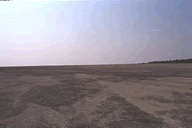
 |
Location:

The balloon base site in Palestine, Texas was first put in use in 1963.
The site was chosen because the area was relatively uninhabited and balloon
launches could be scheduled throughout the year. (Once launched, balloons
can drift for several hundred miles depending on the wind's direction and
speed.) Since that time the population in the surrounding area has increased,
causing NASA to rethink the ballooning schedule. In the early 1980's.,NASA
decided that it was unsafe to launch balloons when it would be likely for
the balloons to drift towards the more densely populated areas. Now balloons
are launched between June and August, when the westwardly direction of the
winds are optimal for directing the balloon towards less populated regions.
Operations:
The Operations Department has a mechanical section, an electronics section,
meteorologists and pilots. It is the department that interacts most closely
with the scientists and the experiments.
|
Mechanical: |
Electronics: |
|
Figure 1. Parachute on the floor in the process of being assembled. |
Figure 2. Photo of Interface Box Tracking Equipment. |
|
Figure 3. High Bay |
Figure 4. Chase plane tracking the flight of the MSAM/TopHat payload, September 1998. |
|
Tracking
Planes:
|
Meteorology: Getting a balloon off the ground is difficult in terms of the weather. Accurate forecasts must always be available. Accurate forecasts of the wind speed directions are also needed. The wind has to be measured at different attitude levels. When the payload leaves the ground, the distance from the bottom to top of one of the large balloons is about 1000 ft. |
 Figure
5. View from center of the launch pad.
Figure
5. View from center of the launch pad.
The Launch Pad:
In 1973 a new 1000-foot diameter launch pad was constructed with an additional
600 feet of "fingers" (roadways that extend outwards from the launch
pad) that extend outside the circle. The fingers are laid out to accomodate
all wind directions. In case the wind changes direction, this launch pad design
maximizes the launch area. This allows the base to launch larger balloons. The
new launch pad has flown a balloon with a volume as large as 70,00,000 cubic
feet.
The Launch Window:
The launch window at the NBSF base in Palestine, Texas is between mid May
and early September. Because of wind patterns at that time of year the balloons
will drift westward during their flight. The area 200 miles west NBSF base is
sparsly populated and the risk of an accident is minimal. In September the winds
begin to change.
Occasionally a balloon has to be brought down prematurely, if the wind direction
causes the balloon to vear in the direaction of a heavily populated area. This
has happened only rarely.
There is a risk of tornadoes in the area. The NBSF staff is always on the lookout
for such an event. However, in 25 years, a tornado has never struck the NBSF
balloon base.
SCIENCE | INSIDE BALLOONS | LAUNCH | GET INVOLVED | TOUR A BALLOON BASE | WHY A BALLOON? | GLOSSARY | GUESTBOOK |